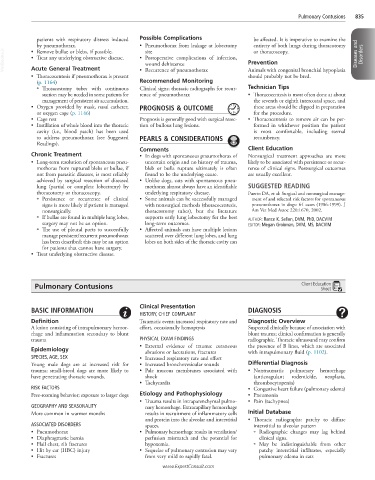Page 1664 - Cote clinical veterinary advisor dogs and cats 4th
P. 1664
Pulmonary Contusions 835
patients with respiratory distress induced Possible Complications be affected. It is imperative to examine the
by pneumothorax. • Pneumothorax from leakage at lobectomy entirety of both lungs during thoracotomy
VetBooks.ir • Treat any underlying obstructive disease. • Postoperative complications of infection, Prevention Diseases and Disorders
site
or thoracoscopy.
• Remove bullae or blebs, if possible.
wound dehiscence
Acute General Treatment
should probably not be bred.
• Thoracocentesis if pneumothorax is present • Recurrence of pneumothorax Animals with congenital bronchial hypoplasia
(p. 1164) Recommended Monitoring
○ Thoracostomy tubes with continuous Clinical signs; thoracic radiographs for recur- Technician Tips
suction may be needed in some patients for rence of pneumothorax • Thoracocentesis is most often done at about
management of persistent air accumulation. the seventh or eighth intercostal space, and
• Oxygen provided by mask, nasal catheter, PROGNOSIS & OUTCOME these areas should be clipped in preparation
or oxygen cage (p. 1146) for the procedure.
• Cage rest Prognosis is generally good with surgical resec- • Thoracocentesis to remove air can be per-
• Instillation of whole blood into the thoracic tion of bullous lung lesions. formed in whichever position the patient
cavity (i.e., blood patch) has been used is most comfortable, including sternal
to address pneumothorax (see Suggested PEARLS & CONSIDERATIONS recumbency.
Readings).
Comments Client Education
Chronic Treatment • In dogs with spontaneous pneumothorax of Nonsurgical treatment approaches are more
• Long-term resolution of spontaneous pneu- uncertain origin and no history of trauma, likely to be associated with persistence or recur-
mothorax from ruptured blebs or bullae, if bleb or bulla rupture ultimately is often rence of clinical signs. Postsurgical outcomes
not from parasitic diseases, is most reliably found to be the underlying cause. are usually excellent.
achieved by surgical resection of diseased • Unlike dogs, cats with spontaneous pneu-
lung (partial or complete lobectomy) by mothorax almost always have an identifiable SUGGESTED READING
thoracotomy or thoracoscopy. underlying respiratory disease. Puerto DA, et al: Surgical and nonsurgical manage-
○ Persistence or recurrence of clinical • Some animals can be successfully managed ment of and selected risk factors for spontaneous
signs is more likely if patient is managed with nonsurgical methods (thoracocentesis, pneumothorax in dogs: 64 cases (1986-1999). J
nonsurgically. thoracostomy tubes), but the literature Am Vet Med Assoc 220:1670, 2002.
○ If bullae are found in multiple lung lobes, supports early lung lobectomy for the best AUTHOR: Rance K. Sellon, DVM, PhD, DACVIM
surgery may not be an option. long-term outcomes. EDITOR: Megan Grobman, DVM, MS, DACVIM
○ The use of pleural ports to successfully • Affected animals can have multiple lesions
manage persistent/recurrent pneumothorax scattered over different lung lobes, and lung
has been described; this may be an option lobes on both sides of the thoracic cavity can
for patients that cannot have surgery.
• Treat underlying obstructive disease.
Pulmonary Contusions Client Education
Sheet
Clinical Presentation
BASIC INFORMATION DIAGNOSIS
HISTORY, CHIEF COMPLAINT
Definition Traumatic event; increased respiratory rate and Diagnostic Overview
A lesion consisting of intrapulmonary hemor- effort, occasionally hemoptysis Suspected clinically because of association with
rhage and inflammation secondary to blunt blunt trauma; clinical confirmation is generally
trauma PHYSICAL EXAM FINDINGS radiographic. Thoracic ultrasound may confirm
• External evidence of trauma: cutaneous the presence of B lines, which are associated
Epidemiology abrasions or lacerations, fractures with intrapulmonary fluid (p. 1102).
SPECIES, AGE, SEX • Increased respiratory rate and effort
Young male dogs are at increased risk for • Increased bronchovesicular sounds Differential Diagnosis
trauma; small-breed dogs are more likely to • Pale mucous membranes associated with • Nontraumatic pulmonary hemorrhage
have penetrating thoracic wounds. shock (anticoagulant rodenticide, neoplasia,
• Tachycardia thrombocytopenia)
RISK FACTORS • Congestive heart failure (pulmonary edema)
Free-roaming behavior; exposure to larger dogs Etiology and Pathophysiology • Pneumonia
• Trauma results in intraparenchymal pulmo- • Pain (tachypnea)
GEOGRAPHY AND SEASONALITY nary hemorrhage. Extracapillary hemorrhage
More common in warmer months results in recruitment of inflammatory cells Initial Database
and protein into the alveolar and interstitial • Thoracic radiographs: patchy to diffuse
ASSOCIATED DISORDERS spaces. interstitial to alveolar pattern
• Pneumothorax • Pulmonary hemorrhage results in ventilation/ ○ Radiographic changes may lag behind
• Diaphragmatic hernia perfusion mismatch and the potential for clinical signs.
• Flail chest, rib fractures hypoxemia. ○ May be indistinguishable from other
• Hit by car (HBC) injury • Sequelae of pulmonary contusion may vary patchy interstitial infiltrates, especially
• Fractures from very mild to rapidly fatal. pulmonary edema in cats
www.ExpertConsult.com

